Colorado business owner William Fuller knew that if he wanted to attract more customers to Summit County Mountain Retreats (SCMR), he’d have think beyond traditional advertising. In a place known for breathtaking scenery, year-round sunshine, and near-limitless outdoor activities, vacation rental companies like Fuller’s aren’t exactly in short supply. A sales email simply wouldn’t cut it. Neither would a print ad, TV spot, or any other typical sales tactics. And it wouldn’t be enough to post enticing photos of inviting hotel rooms, roaring fires, or breathtaking mountain vistas. Everyone did that.
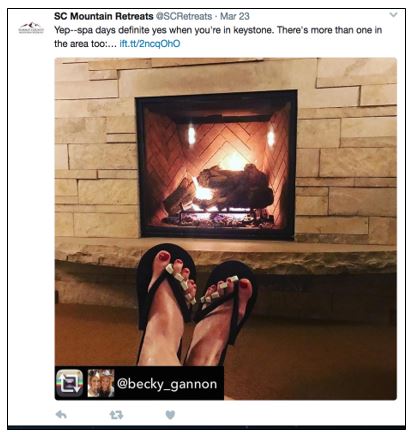 If Fuller really wanted his company to stand out, he’d have to take a completely different approach. He’d need to give potential customers a legitimate reason to choose SCMR over the others. He’d need to cultivate a unique, authentic voice. He’d need to connect with potential guests and provide them with something of real value — before they even booked one of his rental properties.
If Fuller really wanted his company to stand out, he’d have to take a completely different approach. He’d need to give potential customers a legitimate reason to choose SCMR over the others. He’d need to cultivate a unique, authentic voice. He’d need to connect with potential guests and provide them with something of real value — before they even booked one of his rental properties.
So, that’s exactly what he did. Instead of focusing on what made SCMR such a great place to stay, Fuller and his marketing team developed a campaign focused on helping vacationers make the most of their time in Colorado, no matter where they stayed. He turned the SCMR website and social media accounts into resources filled with useful, information about activities and points of interest in the area, particularly things that tend to fly under non-locals’ radars. Most vacationers already know about Colorado’s immensely popular ski slopes in the winter season, but they may not know that they can go snow tubing, take a hot air balloon ride, or plan a day of laid-back luxury at one of the area’s many day spas.
Fuller says that although his new, customer-focused marketing campaign is still in its early stages, he’s confident that his new strategy will pay off in the long term.
Be helpful. Be genuine. Know your customers.
Content marketing isn’t a sales pitch. It’s not a direct advertisement of a product or service —not in the traditional sense, anyway. Essentially, instead of telling potential clients and consumers all the great products or services you might have and want to sell them, or how much money they can save, or how much better what you have is than your competitors, you are instead establishing yourself, and your product, service, or company, as an industry leader.
Michele Linn, senior editorial director at Content Marketing Institute, tells us that, when done correctly, content marketing has the potential to achieve something every business desires: brand loyalty, trust, and a genuine connection with customers.
“Content marketing is different than traditional marketing because, not only are you not interrupting, but you are creating something that is not about your brand, product, or services,” Linn says. “Instead, you are answering questions and being genuinely helpful with the intent of building a subscribed audience.”
But how do you go about being “genuinely helpful?” Start by answering a few simple questions:
- What product or service are you selling?
- Who buys that product or service?
- What are they interested in?
- Where do they (virtually) hang out?
Your answers to these four questions will help you figure out how to reach customers who are most likely to be interested in your product or service — and how to communicate with them.
Are you trying to attract Millennials? Gen X-ers? Baby Boomers? Are your customers high income or middle-class? Are they social media mavens who prefer to engage with the world through the likes of Twitter and Facebook? Would they rather watch a step-by-step product demo or read customer reviews?
Here are a few great examples of content marketing tailored to a specific customer base:
- Farrow & Ball. This 70-year old paint and wallpaper company based in the United Kingdom has a blog, The Chromologist (an expert on color), which focuses on topics related to color that go beyond just paint. Their only brand promotion is in the footer.
- You won’t find many direct plugs for energy drinks on the Red Bull website, but you will find a wide range of content about things like sports, music, video games, and more. Instead of trying to sell to their consumers, Red Bull is positioning itself as a source for information about topics their consumers care about.

- The New York Times has taken sponsored content and “native” ads to an entirely new level. The Gray Lady’s youthful, tech-savvy makeover includes videos, sponsored (high-quality) editorial content, awesome infographics, interactive content, and extras tailored to readers who are likely accessing the paper via screen or mobile device.
- The Wild About Whales website of the New South Wales (NSW) Parks and Wildlife service. The idea to promote whale watching in the off season increased visits to NSW parks by 10 percent in the first year. It started when the community came together to solve the problem of slow business in winter. The campaign targeted parents looking for school holiday activities and used content generated by visitors. Local businesses recommended places to stay, eat, and shop.
”
Start small and remember the big picture
The really great thing about content marketing is that you don’t have to be a huge, multi-bazillion-dollar corporation to really shine. Sure, companies Red Bull and The New York Times are killing it in the 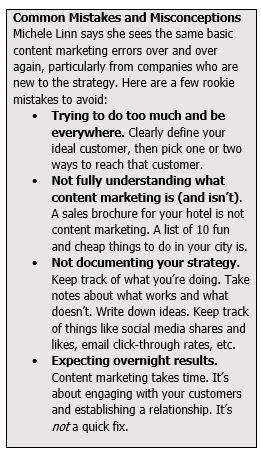 content marketing department — but so is William Fuller, who says his company is getting positive responses to his customer-focused social media posts and helpful travel tips for visitors.
content marketing department — but so is William Fuller, who says his company is getting positive responses to his customer-focused social media posts and helpful travel tips for visitors.
But just because it’s (relatively) easy, don’t expect content marketing to pay off overnight. Unlike traditional direct-sales strategies, content marketing pays off in long-term dividends rather than quickly generated sales leads. Fuller says he and his marketing team have kept this in mind as they build their campaign.
“People today are drawn to experiences,” Fuller says. “We hope to craft content for our blogs, social media outlets, and videos that will attract potential customers to the area . . . which we ultimately hope converts into paying guests.”
Linn is quick to point out that any content marketing campaign takes time, and there are simply no shortcuts. The key to a successful campaign is to keep at it, but keep your expectations realistic.
“On one hand, you need to be committed when you start content marketing,” she says. “Know it will take time, and go all in. On the other hand, start simply. Pick one audience, one platform, and deliver consistently over a long period of time to build your audience.”



 Before we dive into what makes them different, let’s talk about what RFPs, RFIs, and RFQs have in common: They all help companies, government entities, and organizations find vendors that will provide the best services or products, for the right price. (Of course, there’s a little more to it than that. But for the purposes of this blog, we’re going to keep things basic.)
Before we dive into what makes them different, let’s talk about what RFPs, RFIs, and RFQs have in common: They all help companies, government entities, and organizations find vendors that will provide the best services or products, for the right price. (Of course, there’s a little more to it than that. But for the purposes of this blog, we’re going to keep things basic.)
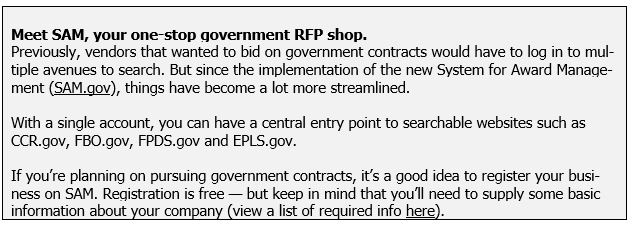
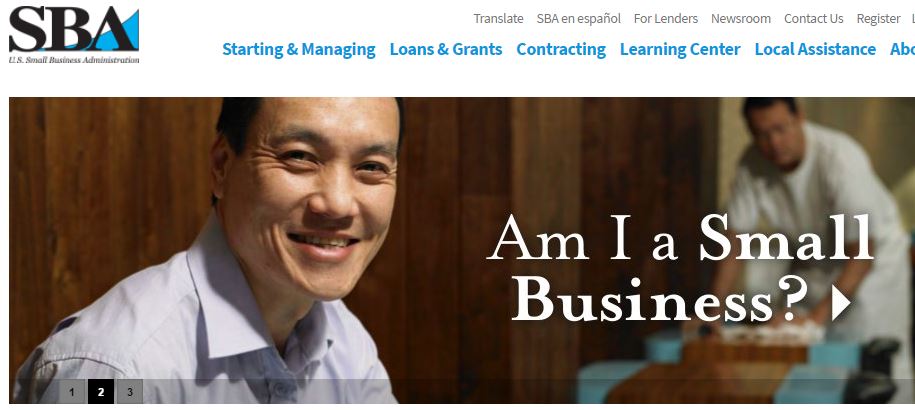


 development, creation, and dissemination. Despite this, hospitals have historically
development, creation, and dissemination. Despite this, hospitals have historically  recipes for arugula salad or learn how to help children cope with parental divorce. In 2014, the American Marketing Association
recipes for arugula salad or learn how to help children cope with parental divorce. In 2014, the American Marketing Association 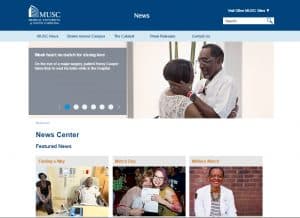 like “Weak Heart No Match for Strong Love,” chronicling a patient’s in-hospital wedding while awaiting major heart surgery. Media and patients alike are drawn to the site, and articles often provide the bases for future media coverage.
like “Weak Heart No Match for Strong Love,” chronicling a patient’s in-hospital wedding while awaiting major heart surgery. Media and patients alike are drawn to the site, and articles often provide the bases for future media coverage.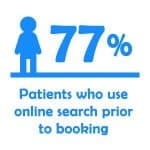 appointments, quality digital content is crucial to convert prospects to acquisitions. As Woolwine explains, “Content marketing forces you to think from the perspective of the consumer or end user. Quite frankly, you should be thinking from that perspective no matter what kind of communicating you’re doing.”
appointments, quality digital content is crucial to convert prospects to acquisitions. As Woolwine explains, “Content marketing forces you to think from the perspective of the consumer or end user. Quite frankly, you should be thinking from that perspective no matter what kind of communicating you’re doing.” put thought and effort into finding the right medical facility, and nearly half
put thought and effort into finding the right medical facility, and nearly half  Scott Linabarger, is a senior healthcare marketing strategist based in Dallas. He is the former VP of Strategic Accounts at Medicom Health and served in senior marketing positions at Tenet Healthcare and Cleveland Clinic.
Scott Linabarger, is a senior healthcare marketing strategist based in Dallas. He is the former VP of Strategic Accounts at Medicom Health and served in senior marketing positions at Tenet Healthcare and Cleveland Clinic. Heather Woolwine serves as the public affairs and media relations director for the Medical University of South Carolina. Founded in 1824, MUSC is one of the nation’s premier academic health science centers. Heather serves as a spokesperson for MUSC, and actively manages the reputation and image of the enterprise through mass and social media relations.
Heather Woolwine serves as the public affairs and media relations director for the Medical University of South Carolina. Founded in 1824, MUSC is one of the nation’s premier academic health science centers. Heather serves as a spokesperson for MUSC, and actively manages the reputation and image of the enterprise through mass and social media relations.